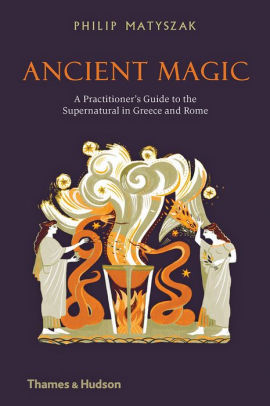This is an odd little book that doesn't neatly fall into any one niche. At its heart it is a moderately scholarly book about the way ancient Greeks and Romans saw the world as one in which magical (that is, inexplicable) things occurred all of the time. Caterpillars turned into butterflies, flowers into fruits and the ancients created a series of systems for harnessing that everyday magic to become godlike. The subtitle 'A Practitioners Guide' is almost actively misleading: Matyszak is not a magic user and clearly finds any belief in the reality of magic (with or without a k) to be sheer superstition, poor psychology, and terrible thinking.
However, I particularly enjoyed how the author married the method and mentality behind how ancient magic was carried out with the relevant myths and legends. For example, in the chapter on divination the author touches on how the ancients saw the future as unchangeable because Fate ordained it. Matyszak then uses the story of Oedipus -- destined to kill his father and marry his mother -- as an illustration while then leading to how the ancients used astrology to reveal their fixed future.
Here's an excerpt:
"In the past it was easier to tell the future. This is because, for the ancients, the future was as unchangeable as the past. What would be, would be. This is not to deny the existence of free will; it was just that people freely took the path leading to their preordained future. Humans can choose, but fate knows what their choice will be.
In Greek myth, the story of Oedipus illustrates this well. The child who was destined to kill his father and marry his mother would not have done any of those things were it not for the extreme measures that everyone voluntarily took to prevent it from happening. On learning the prophecy, the father ordered his baby son to be abandoned on a hillside. Instead, the baby was adopted by the king of Corinth. Unaware of who his real father was, Oedipus met and killed him in a quarrel. Later he married the widow. Had he known his true father from the start, Oedipus would probably have enjoyed a peaceful life– but there is no escape from destiny.
While a modern mechanical Nostradamus has to examine a multitude of probable futures to predict what is to come, the ancients worked with just one fixed future. This made things easier. If there was only one future that was going to happen, no matter what, then the only issue – albeit a big issue – was how to see it. Though difficult, the task was far from impossible. This is because although humans experience time as a sequence of events, the ancients believed that ex-humans (the spirits of the dead) and most divine beings instead saw time as a sort of large and complete flow-chart, on which the present was a moving dot. . . .
Those with an interest in this ancient but also very modern form of divination have an abundance of texts to choose from, most of which are directly or indirectly based on the Tetrabiblos of Claudius Ptolemy. This masterwork on the subject was written in ad 170 and has been regularly published ever since. Readers are recommended to the English translation by Frank Egleston Robbins in the Loeb Classical Library, which has Greek text and facing English translation. Beware of books that include ‘secret’ or ‘forbidden’ chapters of this work. These are modern inventions."
The spells and rituals are almost completely useless to a modern magic worker: reviving a corpse, working with demons, convoluted love spells with poisonous ingredients . . . But there are a few gems hidden within these pages: a simple incantation to the god Morpheus involving cocoa and the recitation of sheep; Simaetha's love spell calling upon the Eurasian woodpecker (a wryneck) to bring her lover to her. It is extensively illustrated and stuffed full of sidebars, making it useful to anyone doing research while the writing style is friendly and approachable. Overall, I found Ancient Magic worth reading for the accessible scholarship and rarely found illustrations.
~review by Lisa Mc Sherry
Author: Philip Matyszak
Thames & Hudson, 2019
pp. 208, $24.95

